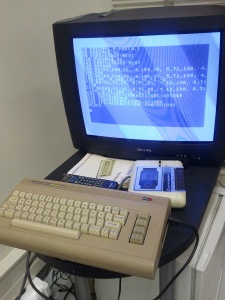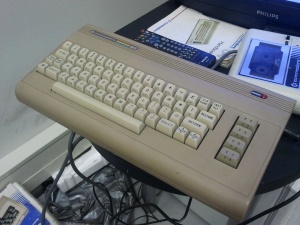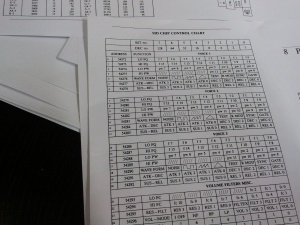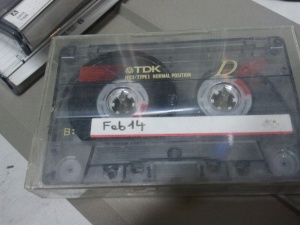User:Fabien Labeyrie/: Difference between revisions
(Created page with "Category:prototyping Category:2011_P1.01 __NOTOC__ __NOEDITSECTION__ <div style="width: 600px; font-family:Arial"> ==<span style="color:#0B0080">C64 Music Programming</s...") |
No edit summary |
||
| Line 5: | Line 5: | ||
<div style="width: 600px; font-family:Arial"> | <div style="width: 600px; font-family:Arial"> | ||
=<span style="color:#0B0080">C64 Music Programming</span>= | |||
<hr style="height:5px; margin-top:-15px; background-color:#FFF"> | <hr style="height:5px; margin-top:-15px; background-color:#FFF"> | ||
<br /> | <br /> | ||
== Presentation == | == <div style="margin-top:30px">Presentation</div> == | ||
<hr style="height:5px; margin-top:-15px; background-color:#FFF"> | <hr style="height:5px; margin-top:-15px; background-color:#FFF"> | ||
Before shaping the feb14 performance project with Inge, the original idea was to use an old Commodore 64 computer as a member of an Electronic Hip-Hop band. | Before shaping the feb14 performance project with Inge, the original idea was to use an old Commodore 64 computer as a member of an Electronic Hip-Hop band. | ||
== The project == | == <div style="margin-top:30px">The project</div> == | ||
<hr style="height:5px; margin-top:-15px; background-color:#FFF"> | <hr style="height:5px; margin-top:-15px; background-color:#FFF"> | ||
| Line 21: | Line 21: | ||
The only way to achieve this is by programming directly in the C64, via the old ''Commodore Basic V2 language''. I found a copy of a very good book entitled "The Commodore 64 Music Book" which help me a with the programming of the first songs. | The only way to achieve this is by programming directly in the C64, via the old ''Commodore Basic V2 language''. I found a copy of a very good book entitled "The Commodore 64 Music Book" which help me a with the programming of the first songs. | ||
Unfortunately, I realized later the ''Datassette'', external tape drive used to store data, was quite unstable. In the end, I wasn't able to record data anymore, making it impossible to build songs in regards to the amount of text necessary to just output a few tones. | Unfortunately, I realized later the ''Datassette'', external tape drive used to store data, was quite unstable. In the end, I wasn't able to record data anymore, making it impossible to build songs in regards to the amount of text necessary to just output a few tones. The project was then aborted. | ||
==<div style="margin-top:30px"> | == <div style="margin-top:30px">Gallery</div> == | ||
<hr style="height:5px; margin-top:-15px; background-color:#FFF"> | <hr style="height:5px; margin-top:-15px; background-color:#FFF"> | ||
<br /> | <br /> | ||
[[image:2011-04-02_21.08.16.jpg | 225px]] | |||
<br /> | <br /> | ||
[[image:2011-04-02_21.08.00.jpg | 300px]] | |||
<br /> | <br /> | ||
[[image:2011-04-02_21.05.51.jpg | 300px]] | |||
<br /> | <br /> | ||
[[image:2011-04-02_21.04.53.jpg | 300px]] | |||
<br /> | <br /> | ||
[[image:2011-04-02_21.04.02.jpg | 300px]] | |||
< | <br /><br /> | ||
</div> | </div> | ||
Latest revision as of 11:45, 7 April 2011
C64 Music Programming
Presentation
Before shaping the feb14 performance project with Inge, the original idea was to use an old Commodore 64 computer as a member of an Electronic Hip-Hop band.
The project
The C64 is very famous among 8-bit music lovers, because it's internal ship, the SID, which is cheap and yet powerful. Usually the SID is extracted from the computer and used in a more contemporary MIDI controller. I took the initial restraint of not opening the C64 (because it was borrowed) as a starting point the create the music.
The only way to achieve this is by programming directly in the C64, via the old Commodore Basic V2 language. I found a copy of a very good book entitled "The Commodore 64 Music Book" which help me a with the programming of the first songs.
Unfortunately, I realized later the Datassette, external tape drive used to store data, was quite unstable. In the end, I wasn't able to record data anymore, making it impossible to build songs in regards to the amount of text necessary to just output a few tones. The project was then aborted.
Gallery





